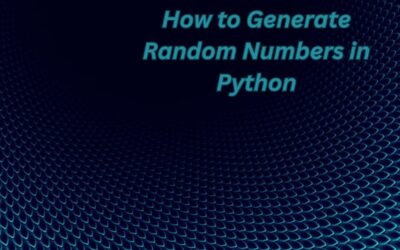In the realm of machine learning, evaluating the performance of a model is crucial to ensure its effectiveness in real-world scenarios. One commonly employed technique for model evaluation is k-fold cross-validation. This article provides a gentle introduction to k-fold cross-validation, exploring its concept, configuration, and practical application through a worked example.
Understanding k-Fold Cross-Validation
K-fold cross-validation is a robust technique widely employed in machine learning for evaluating and validating model performance. The methodology involves dividing the dataset into k subsets or folds. During each iteration, the model is trained on k-1 folds and validated on the remaining fold. This process is repeated k times, ensuring that each fold serves as the validation set at least once. By averaging the final performance metric over these iterations, the approach offers a comprehensive evaluation of the model’s ability to generalize across different subsets of the data. This mitigates the risk of overfitting or underfitting to a specific training set, promoting a more accurate assessment of the model’s capabilities.
Advantages of k-Fold Cross-Validation
Implementing k-fold Cross-Validation provides a more reliable estimate of a model’s performance, contributing to its versatility in handling diverse datasets. The technique significantly enhances the model’s robustness, making it better suited for real-world applications. By repeatedly validating the model on different subsets of the data, k-fold Cross-Validation helps identify potential issues related to dataset variability. This ensures that the model’s generalization is not skewed by a particular set of training instances, fostering confidence in its consistent and reliable performance.
Practical Implications and Confidence Boost
The application of k-fold Cross-Validation holds practical implications for deploying machine learning models in real-world scenarios. By offering a more accurate representation of a model’s true capabilities, it instills confidence in its performance across a variety of situations. The reduced risk of overfitting or underfitting contributes to a more robust and adaptable model, capable of handling different data distributions. As a result, k-Fold Cross-Validation stands as a crucial step in the model development process, ensuring that the performance estimates are not overly optimistic or pessimistic, but rather grounded in a thorough and systematic evaluation.
Configuration of k
Importance of K in Machine Learning: A Key to Optimal Model Performance with K-fold Cross-Validation
The configuration of K, a parameter denoted in various contexts, plays a crucial role in influencing the behavior and outcomes of systems, particularly in machine learning. In this domain, K commonly represents the number of clusters, as seen in algorithms like K-means, significantly impacting the grouping and classification of data points. The precise adjustment of K is essential for fine-tuning models and optimizing their performance. One prominent technique for achieving this optimization is k-fold Cross-Validation, where the dataset is divided into K subsets to validate the model K times, ensuring robustness and reliability in the assessment process.
K’s Role in Networking: Shaping System Connectivity and Performance with K-fold Cross-Validation
In networking, the value of K takes on a different yet equally significant meaning, often signifying a specific variable or threshold that shapes the performance or connectivity of a system. Successful configuration of K in this context demands a nuanced understanding of the underlying networking infrastructure and its objectives. Leveraging k-fold Cross-Validation techniques in network settings can be invaluable, ensuring that the system’s connectivity and performance are thoroughly tested and validated across multiple subsets of the dataset.
System Design and Management: The Pivotal Role of K in Various Domains with K-fold Cross-Validation
Achieving optimal outcomes in artificial intelligence, statistics, or technology infrastructure hinges on the careful configuration of the parameter K. Whether determining the number of clusters in machine learning or setting thresholds in networking, K’s role is pivotal. It is a fundamental step towards ensuring that systems are designed and managed with precision. The integration of k-fold Cross-Validation techniques further enhances the reliability and efficiency of the configured K, making it an integral aspect of system design and management in diverse applications.
Worked Example
In this worked example, we’ll explore the intricacies of optimizing a website for search engines. The process begins with comprehensive keyword research to identify relevant terms for the target audience. Subsequently, on-page optimization techniques, such as meta tag enhancements and content refinement, are implemented to improve the site’s visibility. Off-page strategies, including backlink building and social media engagement, are also crucial components. Throughout this example, we’ll navigate the dynamic landscape of search engine algorithms, emphasizing the importance of staying abreast of industry trends to ensure sustained online success for the website.
k-fold Cross-Validation API
The k-fold Cross-Validation API is a crucial tool in machine learning model evaluation. It involves partitioning the dataset into k subsets, or folds, and iteratively training and testing the model k times. During each iteration, one of the folds serves as the testing set while the remaining k-1 folds are used for training. This process helps assess the model’s performance across various subsets, reducing the risk of overfitting or underfitting to a specific set of data. The API facilitates efficient cross-validation, providing a robust assessment of a model’s generalization capabilities and aiding in the selection of optimal hyperparameters for improved predictive accuracy.
k-fold Cross-Validation
K-fold cross-validation is a robust technique in machine learning used to assess the performance and generalization ability of a model. The dataset is divided into k subsets or folds, and the model is trained and evaluated k times, each time using a different fold as the test set and the remaining as the training set. This process helps mitigate the impact of random data splits, providing a more accurate estimate of a model’s performance. K-fold cross-validation aids in identifying potential issues such as overfitting or underfitting, contributing to the creation of more reliable and effective machine learning models.
Extensions
Advanced techniques like nested cross-validation and repeated cross-validation extend the basic k-fold approach. Nested cross-validation involves an outer loop for model selection and an inner loop for performance evaluation. Repeated cross-validation, on the other hand, repeats the process with different random splits to obtain a more robust assessment of the model.
Further Reading
To deepen your understanding of k-fold cross-validation, exploring additional resources is beneficial. Books like “An Introduction to Machine Learning with Python” by Andreas C. Müller and Sarah Guido provide in-depth coverage, while articles and online tutorials offer practical insights. A solid grasp of cross-validation is crucial for anyone involved in machine learning model development.
Related Tutorials
If you’re interested in expanding your knowledge beyond cross-validation, exploring related tutorials on topics like feature engineering, hyperparameter tuning, and model interpretation can enhance your overall understanding of the machine-learning pipeline.
Summary
In summary, k-fold cross-validation is a powerful tool for evaluating machine learning models, providing a robust estimate of their performance. Understanding the concept, configuring the number of folds, and implementing the process using available APIs are key aspects of mastering this technique. Variations and extensions offer flexibility and adaptability to different scenarios, making k-fold cross-validation an indispensable tool in the machine learning practitioner’s toolkit. Continued exploration and hands-on experience will contribute to your proficiency in leveraging this technique for optimal model assessment.






